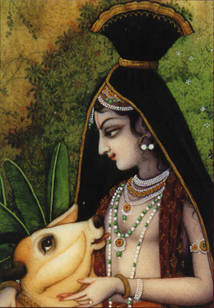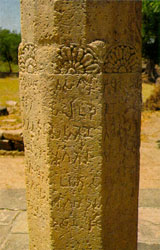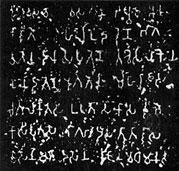Part 1: The Heliodorus Column
 Most Vaisnavas refer to Krishna as having appeared 5,000 years ago and generally credit Vedic civilization and Vaisnavism with great antiquity. But what hard, empirical proof do we have for this assertion? Certainly some archeological or other evidence must exist to confirm or deny these claims. Herein, we shall survey the most prominent archeological discoveries that clearly demonstrate the antiquity of Krishna worship and Vaisnavism.
Most Vaisnavas refer to Krishna as having appeared 5,000 years ago and generally credit Vedic civilization and Vaisnavism with great antiquity. But what hard, empirical proof do we have for this assertion? Certainly some archeological or other evidence must exist to confirm or deny these claims. Herein, we shall survey the most prominent archeological discoveries that clearly demonstrate the antiquity of Krishna worship and Vaisnavism.
First of all, detailed historical evidence of Vedic civilization is not that easy to come by, since the Vedic culture itself seems to have not valued the keeping of histories. In his book Traditional India, O. L. Chavarria-Aguilar writes of Indians: "A more unhistorical people would be difficult to find." Vedic civilization believed in recording the eternal and infinite. The ephemeral details of daily life (so much the concern of contemporary people) need not be recorded, since they had so little bearing on the larger, more significant goals of human life. Leisure time was to be used for self-realization, cultural pursuits, and worship of God–not rehashing current events or the past. Therefore, practically no histories, according to the Western concept of history, exist today about ancient India, because none were written.
Into this vacuum of historical data on India’s past stepped the European scholars during the last several hundred years, and it is interesting to note how they first dealt with what they found. Religious scholars were especially shocked to observe the remarkable similarities between the lives and philosophies of Krishna and Jesus Christ. As a defensive reflex they automatically assumed that Indians must have come across Christianity in the early centuries after Christ’s ministry and had assimilated much of it into their own religious tradition. This slant on Vaisnavism was called "the borrowing theory" and gained many adherents in the West. Concerning this viewpoint, Hemchandra Raycaudhuri in his book Materials for the Study of the Early History of the Vaisnava Sect writes, "The appearance in India of a religion of Bhakti [devotion] was, in the opinion of several eminent Western scholars, an event of purely Christian origin. Christianity, according to these scholars, exercised an influence of greater or less account on the worship and story of Krishna."
In 1762 in Rome, P. Georgi was the first Western scholar to propound this theory. In his Alphabetum Tibetanum he wrote that "Krishnu" is only a "corruption of the name of the Saviour; the deeds correspond wonderfully with the name, though they have been impiously and cunningly polluted by most wicked imposters." The extreme fanaticism of Georgi’s position was soon repudiated by other Western scholars. Even pro-Christian researchers admitted that the name Krishna existed before the birth of Jesus, but they still maintained that the life of Krishna and the philosophy of Vaisnavism had undergone major transformations because of Christian influence.
 In his monograph Uber die Krishnajanmasthami, Albrecht Weber pointed out the many and striking similarities between the birth stories of Krishna and Jesus. The following quote from his work notes many of these similarities:
In his monograph Uber die Krishnajanmasthami, Albrecht Weber pointed out the many and striking similarities between the birth stories of Krishna and Jesus. The following quote from his work notes many of these similarities:
Take, for example the statement of the Vishnu Purana that Nanda, the foster-father of Krishna, at the time of the latter’s birth, went with his pregnant wife Yasoda to Mathura to pay taxes (cf. Luke II, 4, 5) or the pictorial representation of the birth of Krishna in the cowstall or shepherd’s hut, that corresponds to the manger, and of the shepherds, shepherdesses, the ox and the ass that stand round the woman as she sleeps peacefully on her couch without fear of danger. Then the stories of the persecutions of Kamsa, of the massacre of the innocents, of the passage across the river (Christophorus), of the wonderful deeds of the child, of the healing-virtue of the water in which he was washed, etc., etc. Whether the accounts given in the Jaimini Bharata of the raising to life by Krishna of the dead son of Duhsala, of the cure of Kubja, of her pouring a vessel of ointment over him, of the power of his look to take away sin, and other subjects of the kind came to India in the same connection with the birth-day festival may remain an open question.
Weber even contended that the whole Vedic system of avatars, or incarnations of God, was "borrowed" from the "Incarnation of Jesus Christ."
Dr. F. Lorinser translated the Bhagavad-gita and compared it scrupulously to the New Testament. He concluded, writes Raychaudhari, "that the author of the Hindu poem knew and used the Gospels and Christian Fathers." According to Lorinser, continues Raychaudhari, the similarities were "not single and obscure, but numerous and clear …" There was no doubt in Lorinser’s mind that the Bhagavat-gita had been largely "borrowed" from the New Testament.
Other Western scholars disputed the borrowing theory. Sir William Jones’ studies found Krishna to be one of the more ancient gods of India, who Vaisnavas asserted was "distinct from all the Avatars, who had only [a]…portion of his divinity …" In his fascinating and provocative work, On the Gods Of Greece, Italy, And India, Sir William Jones writes that "in the principal Sanskrit dictionary, compiled about two thousand years ago, Krishna, Vasudeva, Govinda, and other names of the Shepherd God, are intermixed with epithets of Narayana, or the Divine Spirit." Following in the direction of Sir Jones’ research, Edward Moore even went so far as to say that the popular Greek myths had some basis in real life and could be traced ultimately to India. However, solid proof for either side escaped their grasp, and the scholars theorized and debated the issue back and forth. Literary evidence did exist in India to prove that Vaisnavism predated Christianity, but this evidence was brushed under the rug and given little credence until a Western literary source decided the issue once and for all.
 The most important and earliest non-Indian literary record of ancient India is found in the book, Indica, written by Megasthenes. Sometime in the third century BC, Meghastenes journeyed to India. The King of Taxila had appointed him ambassador to the royal court at Pataliputra of the great Vaisnava monarch, Chandragupta. Evidently while there, Megasthenes wrote extensively on what he heard and saw. Unfortunately, none of Megasthenes’ original book survived the ravages of time. However, through Megasthenes’ early Greek and Roman commentators, like Arrian, Diodorus, and Strabo, fragments of his original work are available to us today, as well as Megasthenes’ general message. Dr. Hein reports that Megasthenes "described Mathura as a place of great regional importance and suggested that it was then, as now, a center of Krishna worship."
The most important and earliest non-Indian literary record of ancient India is found in the book, Indica, written by Megasthenes. Sometime in the third century BC, Meghastenes journeyed to India. The King of Taxila had appointed him ambassador to the royal court at Pataliputra of the great Vaisnava monarch, Chandragupta. Evidently while there, Megasthenes wrote extensively on what he heard and saw. Unfortunately, none of Megasthenes’ original book survived the ravages of time. However, through Megasthenes’ early Greek and Roman commentators, like Arrian, Diodorus, and Strabo, fragments of his original work are available to us today, as well as Megasthenes’ general message. Dr. Hein reports that Megasthenes "described Mathura as a place of great regional importance and suggested that it was then, as now, a center of Krishna worship."
Christian Lassen was the first Western scholar to bring Megasthenes into the debate on the "borrowing theory." He noted that Megasthenes wrote of Krishna under the pseudonym of Heracles and that "Heracles", or Krishna, was worshipped as God in the area through which the Yamuna River flows.
 A respected Indologist, Richard Garbe, agreed with Lassen’s analysis and called the testimony of Megasthenes indisputable. Soon, scholars like Alan Dahlquist, who had formerly supported the "borrowing theory," changed their minds and admitted, in Dahlquist’s words, that Garbe had "exploded Weber’s theory once and for all." The life of Krishna and the religion of Vaisnavism had not been influenced by Christianity, but had appeared autonomously on Indian soil and was already well-established by at least the third century BC.
A respected Indologist, Richard Garbe, agreed with Lassen’s analysis and called the testimony of Megasthenes indisputable. Soon, scholars like Alan Dahlquist, who had formerly supported the "borrowing theory," changed their minds and admitted, in Dahlquist’s words, that Garbe had "exploded Weber’s theory once and for all." The life of Krishna and the religion of Vaisnavism had not been influenced by Christianity, but had appeared autonomously on Indian soil and was already well-established by at least the third century BC.
With Megasthenes’ proof in hand, the credibility of Indian literary sources became enhanced. The great grammarian and author of the Yoga Sutras, Patanjali, who lived in the second century BC, wrote that Krishna had slain the tyrant Kamsa in the far distant past. Raychaudhari tells us the exact words were "chirahate Kamse’ which means that Kamsa’s death occurred at a very remote time." In the fifth century BC, the greatest Sanskrit grammarian, Panini, mentions that Vaisnavism "was even in the fifth century BC a religion of Bhakti," writes Raychaudhari. The Artha-shastra of Kautila, from the fourth century BC, also refers several times to Krishna, while the Baudhayana Dharma Sutra of the same century gives twelve different names for Krishna, including popular ones like Keshava, Govinda, and Damodara.
Since Krishna is mentioned in the pre-Buddhistic Chandogya Upanishad we must conclude that Krishna lived before Gautama Buddha (563?-?483 BC). The scriptures of the Jains push Krishna’s life back farther still. Raychaudhari writes, "Jaina tradition makes Krishna a contemporary of Arishtanemi… who is the immediate predecessor of Parsvanatha…. As Parsvanatha flourished about 817 B.C., Krishna must have lived long before the closing years of the ninth Century B.C." Of course, the Srimad Bhagavatam and Mahabharata themselves place Krishna’s life at about 3000 BC. Still, whatever the exact dates of Krishna’s earthly appearance and disappearance, because of the abundance of evidence of Krishna’s antiquity, The Cambridge History of India definitely states that Krishna worship predates Christianity by many centuries.
Let us now turn our attention to the earliest archeological discoveries regarding Krishna’s antiquity. By far the most important discovery was made by the indefatigable General Sir Alexander Cunningham in 1877. During an archeological survey of Beshnagar in central India, he noted an ornamental column. The shape of the column caused Cunningham to attribute it erroneously to the period of the Gupta Dynasty (AD 300-550). Thirty-two years later, however, a Mr. Lake felt he saw some lettering on the lower part of the column in an area where pilgrims customarily smeared it with a lead, vermilion paint. When the thick, red paint was removed, Lake’s hunch was proven correct.
Dr. J. H. Marshall, who accompanied Mr. Lake on this investigation, was thrilled at the find’s significance. In the Journal of the Royal Asiatic Society in 1909, he described his conclusions. Cunningham had dated the column far too late and could little have dreamt of the value of the record which he just missed discovering…. A glance at the few letters exposed was all that was needed to show that the Column was many centuries earlier than the Gupta era. This was, indeed, a surprise to me, but a far greater one was in store when the opening lines of the inscription came to be read.

The following transliteration and translation of this ancient Brahmi inscription was published in the Journal of the Royal Asiatic Society (London: JRAS, Pub., 1909, pp. 1053-54.
1) Devadevasa Va [sude]vasa Garudadhvajo ayam 2) karito i[a] Heliodorena bhaga- 3) vatena Diyasa putrena Takhasilakena 4) Yonadatena agatena maharajasa 5) Amtalikitasa upa[m]ta samkasam-rano 6) Kasiput[r]asa [Bh]agabhadrasa tratarasa 7) vasena [chatu]dasena rajena vadhamanasa
"This Garuda-column of Vasudeva (Visnu), the god of gods, was erected here by Heliodorus, a worshipper of Visnu, the son of Dion, and an inhabitant of Taxila, who came as Greek ambassador from the Great King Antialkidas to King Kasiputra Bhagabhadra, the Savior, then reigning prosperously in the fourteenth year of his kingship."
The column had been erected in BC 113 by Heliodorus, a Greek ambassador to India. He, like Megasthenes, hailed from Taxila in the Bactrian region of northwest India, which had been conquered by Alexander the Great in BC 325. By Heliodorus’ time Taxila covered much of present-day Afghanistan, Pakistan, and the Punjab. Taxila’s king, Antialkidas, had sent Heliodorus to the court of King Bhagabhadra, but while Megasthenes had only written about Krishna and Vaisnavism, Heliodorus had found them so attractive that he had adopted the practice of Vaisnavism for his own spiritual advancement!
Heliodorus’ Column recognized Vasudeva, or Krishna, as the "God of gods."
1) Trini amutapadani‹[su] anuthitani 2) nayamti svaga damo chago apramado
"Three immortal precepts (footsteps)... when practiced lead to heaven‹self-restraint, charity, consciousness."
From this inscription it is clear Heliodorus was a Vaisnava, a devotee of Visnu.
 Raychaudhuri maintains that Heliodorus most probably was already acquainted with Vaisnavism in Taxila, even before he went to India proper, since, "It was at that city that Janamejaya heard from Vaishampayana the famous story of the Kurus and the Pandus [the Mahabharata]." Furthermore, Raychaudhuri then suggests, "Heliodorus of Taxila actually heard and utilized the teaching of the great Epic, " since we know from Panini that the Epic was "well known to the people of Gandhara [Taxila]" long before the time of the Greek ambassador.
Raychaudhuri maintains that Heliodorus most probably was already acquainted with Vaisnavism in Taxila, even before he went to India proper, since, "It was at that city that Janamejaya heard from Vaishampayana the famous story of the Kurus and the Pandus [the Mahabharata]." Furthermore, Raychaudhuri then suggests, "Heliodorus of Taxila actually heard and utilized the teaching of the great Epic, " since we know from Panini that the Epic was "well known to the people of Gandhara [Taxila]" long before the time of the Greek ambassador.
 In any case, by BC 113 Heliodorus publicly acknowledged in the most conspicuous way that he held Vasudeva, or Krishna to be the "Gods of all gods." He also had written on his column’s inscription that "Three immortal precepts when practiced lead to heaven–self-restraint, charity, and conscientiousness." These three virtues appear in the exact same order in the Mahabharata, which makes Professor Kunja Govinda Swami of Calcutta University conclude that Heliodorus "was well acquainted with the texts dealing with the Bhagavat [Vaisnava] religion." Raychaudhuri concurs that "there was some close connection between the teaching of the Mahabharata and that of the Besnagar Inscription," proving that Heliodorus was a knowledgeable devotee of Vaisnavism.
In any case, by BC 113 Heliodorus publicly acknowledged in the most conspicuous way that he held Vasudeva, or Krishna to be the "Gods of all gods." He also had written on his column’s inscription that "Three immortal precepts when practiced lead to heaven–self-restraint, charity, and conscientiousness." These three virtues appear in the exact same order in the Mahabharata, which makes Professor Kunja Govinda Swami of Calcutta University conclude that Heliodorus "was well acquainted with the texts dealing with the Bhagavat [Vaisnava] religion." Raychaudhuri concurs that "there was some close connection between the teaching of the Mahabharata and that of the Besnagar Inscription," proving that Heliodorus was a knowledgeable devotee of Vaisnavism.
The Heliodorus Column also struck down the myth that the Vedic religion never condoned the conversion of non-Indians to its fold. While this exclusionary tendency has been manifest here and there in India (although much less so in Vaisnavism), the Islamic historian, Abu Raihan Alberuni, maintains that it was not practiced until sometime after the Muslim incursions into India, which started around AD 674. Alberuni went to India to study in AD 1017 and published his findings in his book Indica (not to be confused with Megasthenes’ work of the same title). He concluded that the violent conflicts and forced conversions of Indians into Muslims made Indians adopt an exclusionary policy, more out of self-defense than religious principle. He discovered that, for many centuries prior to the Muslim invasions, there was no bar to conversions, and the Heliodorus Column certainly attests to this fact.
Part 2: Further Antiquities

![]() Presently, Heliodorus is the earliest Westerner on record who actually converted to Vaisnavism. Moreover, many reputable scholars, like Dr. A. L Basham and Dr. Thomas Hopkins, declare that Heliodorus was not the only Greek to convert. Dr. Hopkins, Chairman of the Department of Religious Studies at Franklin and Marshall college, says, "Heliodorus was presumably not the only foreigner who was converted to Vaisnava devotional practices (although he might have been the only one to erect a column, at least one that is still extant). Certainly there must have been many other." The Vedic religion saw itself as universal and welcomed all peoples into its embrace. As Raychaudhari writes:
Presently, Heliodorus is the earliest Westerner on record who actually converted to Vaisnavism. Moreover, many reputable scholars, like Dr. A. L Basham and Dr. Thomas Hopkins, declare that Heliodorus was not the only Greek to convert. Dr. Hopkins, Chairman of the Department of Religious Studies at Franklin and Marshall college, says, "Heliodorus was presumably not the only foreigner who was converted to Vaisnava devotional practices (although he might have been the only one to erect a column, at least one that is still extant). Certainly there must have been many other." The Vedic religion saw itself as universal and welcomed all peoples into its embrace. As Raychaudhari writes:
The Beshnagar record testifies to the proselytizing zeal of the Bhagavatas in the pre-Christian centuries, and shows that their religion was excellent enough to capture the hearts of cultured Greeks, and catholic enough to admit them into its fold.
The Mora Well and Ghosundi Inscriptions tell us that the rich and complex Vaisnava conception of the Godhead and full expansions of the Godhead into the material universes were already well established in the first two centuries before Christ. The Srimad Bhagavatam says, that when the original Godhead, or Krishna, appears on the earthly plane, the Godhead always is accompanied by various complete expansions of the Godhead, who both possess the full potency of the Godhead and are worshipable. The Srimad Bhagavatam states, "Lord Krishna, the Personality of Godhead, along with Balarama, played like a human being, and so masked, he performed many superhuman acts." His divine Grace A. C. Bhaktivedanta Swami Prabhupada explains the system of divine expansion:
… Balarama and Krsna are original forms of the Lord… Krsna… is the Supreme Personality of Godhead, and Balarama is the first plenary manifestation of the Lord. From Balarama the first phalanx of the plenary expansions, Vasudeva, Sankarsana, Aniruddha and Pradyumna, expands. Lord Sri Krsna is Vasudeva, and Balarama is Sankarsana.
Seven miles west of Mathura in the small and unimposing village of Mora, General Cunningham made another vital find regarding the historicity of Vaisnavism. In 1882, on the terrace of an ancient well, he discovered a large stone slab filled with inscriptions. Although more than half of the writing had already peeled away on the right side, the remainder was legible. It was transcribed, and a facsimile of the inscription was published in the Archaeological Survey of India’s Annual Report. The message was clear. Not only was Krishna worshiped in the centuries before Christ, but also His expansions or associates, especially "the five heroes of the Vrishni Clan." Scholarly research makes evident that these five are Krishna (Vasudeva), Balarama (Sankarshana), Pradyumna, Samba, and Aniruddha.
In 1908, a Dr. Vogel had the Mora Well slab removed to the Mathura Museum and tried to tamper with the translations of the inscriptions in order to throw the Vedic religion into a bad light. However, because the contents of the inscriptions had already been published authoritatively and were well known in academic circles, Dr. Vogel’s efforts at creating disinformation failed. The complex theology, metaphysics, and cosmology of Sanatana Dharma and Vaisnavism definitely existed in an advanced state centuries before Christ. The Mora Well inscription is an important archeological proof of this historical fact.
In the village of Ghosundi in the Chitor district of Rajasthan is found the Ghosundi Inscription, which largely duplicates the message of the Mora Well Inscription. Kaviraja Shyamala Dasa first brought this evidence to light in The Journal of the Bengal Asiatic Society. Today, the inscription can be inspected in the Victoria Hall Museum in Udaipur.
The surviving part of this inscription relevant to this chapter reads as follows:
[this] railing of stone for the purposes of worship is [caused to be made] in the Narayana-compound, [dedicated] to the Blessed Ones [bhagavabhyam] Samkarshana and Vasudeva, the gods…
 The inscription is in a form of Sanskrit script called Northern Brahmi script, which dates the inscription as being from the second century BC in either the late Maurya or early Sunga periods. An almost identical inscription also was uncovered nearby and is called the Hathi-vada Inscription. These inscriptions also dispel the myth that Krishna was only revered by the ksatriya, or administrative-warrior, class of India, the class Krishna had appeared in. According to K. P. Jayaswal of the Archaeological Survey of India, these inscriptions demonstrate that brahmins, the priestly and intellectual class, also worshiped Krishna as the "Lord of all," and thus Vaisnavism was entrenched in the entire Indian society.
The inscription is in a form of Sanskrit script called Northern Brahmi script, which dates the inscription as being from the second century BC in either the late Maurya or early Sunga periods. An almost identical inscription also was uncovered nearby and is called the Hathi-vada Inscription. These inscriptions also dispel the myth that Krishna was only revered by the ksatriya, or administrative-warrior, class of India, the class Krishna had appeared in. According to K. P. Jayaswal of the Archaeological Survey of India, these inscriptions demonstrate that brahmins, the priestly and intellectual class, also worshiped Krishna as the "Lord of all," and thus Vaisnavism was entrenched in the entire Indian society.
The same point is made in the famous Nanaghat Cave Inscription in the moder state of Maharashtra, where Vasudeva and Sankarshana (or Krishna and Balarama) are included in an invocation of a brahmin. Additionally, Raychaudhuri reports:
The Nanaghat Inscription shows further that the Bhagavata [Vaisnava] religion was no longer confined to Northern India, but had spread to the south and had captured the hearts of the sturdy people of Maharashtra. From Maharashtra it was destined to spread to the Tamil country and then flow back with renewed vigour to the remotest corners of the Hindu world.
On epigraphical grounds, this inscription is dated conclusively as coming from the second half of the first century BC.
Krsna, Agathocles coin,
Ai Khanoum, Afghanistan, 2nd century B.C.
 A lot of numismatic evidence also corroborates the antiquity of Krishna. For instance, excavations at Ai-Khanum, along the border of Afghanistan and the Soviet Union, conducted by P. Bernard and a French archeological expedition, unearthed six rectangular bronze coins issued by the Indo-Greek ruler Agathocles (180?-?165 BC). The coins had script written in both Greek and Brahmi and, most interestingly, show an image of Vishnu, or Vasudeva, carrying a Chakra and a pear-shaped vase, or conchshell, which are two of the four main sacred symbols of God in Vaisnavism. Many other finds of ancient coins also prove the antiquity of Krishna worship in India.
A lot of numismatic evidence also corroborates the antiquity of Krishna. For instance, excavations at Ai-Khanum, along the border of Afghanistan and the Soviet Union, conducted by P. Bernard and a French archeological expedition, unearthed six rectangular bronze coins issued by the Indo-Greek ruler Agathocles (180?-?165 BC). The coins had script written in both Greek and Brahmi and, most interestingly, show an image of Vishnu, or Vasudeva, carrying a Chakra and a pear-shaped vase, or conchshell, which are two of the four main sacred symbols of God in Vaisnavism. Many other finds of ancient coins also prove the antiquity of Krishna worship in India.
Balarama, Agathocles coin,
Ai Khanoum, Afghanistan, 2nd century B.C.
 To summarize, today the weight of empirical evidence proves that Krishna and Vaisnavisam predate Christianity. Numerous literary, archeological, and numismatic sources build an unassailable case. Nevertheless, Vaisnavism and Christianity still show amazing similarities. In the chauvinistic and sectarian atmosphere of the eighteenth and nineteenth centuries, these similarities led most Western scholars to adopt the now discredited "borrowing theory." But these attitudes did more that distort the truth. In the twentieth century they directly led to two world wars of unprecedented ferocity and destruction. Therefore, sensitive and caring people perceive these attitudes as being obsolete, and, instead of clinging to them, more intelligent people now seek the path of unity. Even in religion, one of the key contemporary attitudes is the ecumenical spirit, the desire to emphasize more our similarities with other peoples, nations, and religions rather than our differences.
To summarize, today the weight of empirical evidence proves that Krishna and Vaisnavisam predate Christianity. Numerous literary, archeological, and numismatic sources build an unassailable case. Nevertheless, Vaisnavism and Christianity still show amazing similarities. In the chauvinistic and sectarian atmosphere of the eighteenth and nineteenth centuries, these similarities led most Western scholars to adopt the now discredited "borrowing theory." But these attitudes did more that distort the truth. In the twentieth century they directly led to two world wars of unprecedented ferocity and destruction. Therefore, sensitive and caring people perceive these attitudes as being obsolete, and, instead of clinging to them, more intelligent people now seek the path of unity. Even in religion, one of the key contemporary attitudes is the ecumenical spirit, the desire to emphasize more our similarities with other peoples, nations, and religions rather than our differences.
If Westerners can drop their defenses and look at Vaisnavism with ecumenical eyes, they will see a religion and a philosophy which undoubtedly through the Greeks helped to shape the soul of Western civilization itself and its largest religion, Christianity. Rather than being shocked by the similarities, we ought to rejoice in them. From at least our vantage point and in light of all the material presented in this book and from other sources, it is obvious to us that Christians and Vaisnavas are worshiping the same original Godhead and are seeking salvation and solace from that Godhead through the same transcendental, personal loving relationship.
The early Western researchers into Vaisnavism were correct in at least this sense: there are too many similarities between Vaisnavism and Christianity for it to be mere coincidence. And since the "borrowing theory" cannot explain it, we suggest that both religions emanate form the same divine revelatory source-God. The message of Krishna in the Bhagavad-gita and the message of Jesus Christ in the New Testament are identical in essence: recognize the loving existence of your Divine Father and enter into a personal loving relationship with God. Each religion has developed this philosophy with different areas of strength. Vaisnavism presents a far more systematic and scientific explanation of divinity and metaphysics, while christianity in the West is proving more adept at putting the philosophy of God’s love into practical action in areas like economic advancement, human rights, and political participation. If the ecumenical spirit grows and predominates in both East and West, then these two great religions can share their strengths openly with each other to create a civilization that would be far more evolved and cultured than anything that exists today. In the end the issue really isn’t who borrowed what from whom. For a true Vaisnava or Christian this issue is resolved simply—everything we have is borrowed ultimately from God. God is the original source, and God is one.




